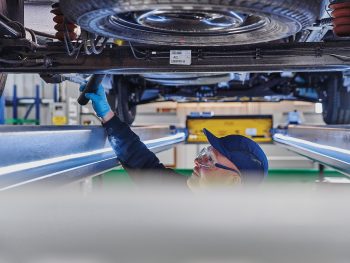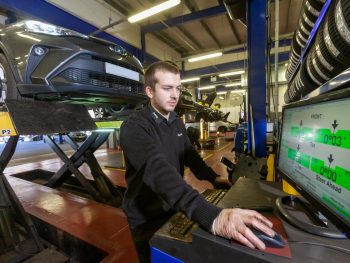Service as usual? How EVs are changing fleet SMR
The transition to electric vehicles brings a host of new considerations for fleet servicing, maintenance and repairs. Natalie Middleton explores the main issues.

Research from ARI Fleet UK shows that savings of upwards of 20-25% on SMR may be achieved on EVs versus ICE vehicles
As the much-fabled tipping point for electric vehicle adoption by fleets arrives, so too do a number of extra considerations; from adapting the fleet policy through to driver training and charging.
But they also bring additional factors for servicing, maintenance and repairs (SMR), with a number of issues to take on board.
According to Matt Cranny, director of leasing & complete at ARI Fleet UK, the big impact to SMR from increased adoption of electric vehicles is simple – he says fleet operators will be doing less SMR work.
He explains: “Electric vehicles have fewer moving parts, they don’t need oil, have longer service schedules and benefit from reduced wear and tear on key items such as brake pads and discs due to the regenerative braking systems.
“Our early research shows that savings of upwards of 20-25% on SMR may be achieved on EVs versus ICE vehicles.”
It’s a figure that Fleet Alliance commercial director David Blackmore agrees with. While he says that for service bookings, EVs are no different to ICE vehicles in terms of booking them in regularly and following manufacturer warranty guidelines – and that the company would always recommend a full maintenance package with any lease contract – he adds that EVs can be significantly cheaper.
“We often quote the figures for the Hyundai Ioniq full electric car versus the Ioniq hybrid to underline the point, as they are essentially the same cars but with different powertrains,” comments Blackmore. “On a 10,000 miles per annum maintenance contract, the Ioniq electric costs £12 per month, while the hybrid is £18 per month – a saving of around 33%. So, it’s clearly apparent that the BEV is cheaper to maintain, regardless of mileage.”
And as well as being cheaper, Arval UK senior consultant David Watts says EVs are expected to be more reliable too, so fleets will experience less downtime and costs associated with unscheduled maintenance and repairs.
He adds: “The service schedule for an EV is likely to be longer than for an equivalent ICE vehicle. Traditional vehicles typically need at least an oil change every 12 months, whereas an EV may not need a first service for up to two years.”
And LeasePlan says that the actual fleet and leasing sector data on SMR costs for EVs is becoming far more accurate too, as the industry passes the early adopter phase and goes into mainstream adoption as a whole.
Caroline Sandall, specialist consultant at LeasePlan UK, explains: “This level of insight allows us to set budgets that are a truer reflection of the SMR costs for each vehicle, meaning that the customer is paying for what they are actually likely to use.”
But Peter Golding, managing director of FleetCheck, warns that the picture on SMR costs may change as higher-mileage car drivers and – in particular – van fleets adopt them, changing everything from how hard these vehicles are driven, to whether they are leased or owned and where they are typically maintained.
“It’s so easy to look at the headlines and say, ‘Yes, they cost less than ICE vehicles.’ But actually when you go deeper into the subject and you start thinking about the ramifications of the type of use, only time will tell as to whether that those savings are going to be passed on to fleets.”
A change of focus

ATS says that consideration should be paid to a like-for-like replacement policy due to the benefits of specialist EV tyres
As a result, Kwik Fit says that fleets will need to assess their balance of repair and servicing requirements as with the swing towards fully electric vehicles.
“With fewer components under the bonnet and lower wear on brake friction parts due to regenerative braking, the focus shifts more towards tyres and items such as brake fluid, windscreen wipers and bulbs, in the short-term,” says Kwik Fit fleet director Dan Joyce. “Factors such as Advanced Driver Assistance Systems (ADAS) calibration should also be considered at this stage due to increasing levels of vehicle autonomy.”
Most in the industry agree that tyres are a particularly important consideration – including Matt Cranny of ARI who says fleet managers must exercise caution here due to the bespoke nature of EV tyres.
“The design of EV tyres is specific to the running characteristics of electric vehicles – they perform under greater weights and increased torque, have lower rolling resistance and run more quietly. They differ in size, material, load and, in many cases, have different tread depths. With all these considerations, incorrect fitting of tyres on EVs can cause issues such as increased wear rates, louder tyre noise and reduced battery ranges (up to 20%).”
ATS Euromaster also says that consideration should be paid to a like-for-like replacement policy due to the benefits of specialist EV tyres. But Mark Holland, operations director, adds: “Although it’s always recommended to change tyres like-for-like where possible, as this will offer the best vehicle performance, this isn’t mandatory.
“What is important when it comes to replacement is that the correct tyre size and load ratings for the vehicle are used, no matter which product is selected.”
ARI’s Matt Cranny adds that fleets must also factor in tyre availability.
“EV tyres make up a tiny fraction of the UK’s general demand for replacement tyres at present, so ensuring your fleet has access to specialist tyres when needed is vital to reduce vehicle and driver downtime.”
An impact on downtime?

AFP chair Paul Hollick
The Association of Fleet Professionals (AFP) also warns of possible delays with fast-fit replacements, in particular in more rural areas, and says that fleets need to be prepared for this until EVs become more widespread.
It also warns that fleets are seeing increased downtime in the event of an accident involving an EV.
Chair Paul Hollick comments: “I think fleet managers need to expect that if an electric vehicle is in an accident, it’s probably going to be off the road an extra couple of days, so they need to plan for that – potentially putting an employee into a hire vehicle.”
And Peter Golding of FleetCheck advises of anecdotes where relatively straightforward accident repairs are taking longer.
“I’ve heard of cases where the vehicle has to be recovered to a main dealer to have the electrics done then recovered back to the body shop to do the body repairs.”
Meanwhile, Steve Thornton, commercial director at specialist fleet management provider i247 Group, warns that fleet managers need to be aware of the volume of warranty issues they may face from drivers, and the number of recalls from manufacturers.
He adds that this is not to do with the fact that the cars are EVs – the perception that EVs have more problems is wrong – but all brand-new model entrants come with a variety of warranty issues that are typical of early model releases and new product features.
“Earlier this year there was an issue with the VW ID.3 and its infotainment system and BMW 530e with its charging cable,” says Thornton. “None of this is atypical. The warranty claims on new EVs are at a similar level to the warranty claims on new ICE cars. Nevertheless, fleet managers should be prepared for more off-the-road warranty time for new EVs.”
Qualified for the job?

Kwik Fit is also placing a huge importance on training with over 500 of its technicians qualified to work on EVs
While fleets are increasingly adopting EVs, the Institute of the Motor Industry (IMI) warns this speed may not be being matched by the ability of the SMR sector to support these vehicles.
While the franchise networks are fast-ramping up their EV skills, the latest data from the IMI shows that as of June 2021, just 6.5% of the UK automotive industry overall is qualified to work on electric vehicles.
It’s something the IMI has huge concerns over, both for fleet downtime and the risk of someone trying to fix a problem that they’re not qualified to tackle, with the consequent risk of injury or death.
As such, Steve Scofield, IMI head of business development, says fleets need to have a very clear policy about how SMR should be handled for EVs.
He comments: “There can’t be a default to the same technician workforce used for petrol and diesel unless a fleet manager has clear indication that accredited EV training has been completed. And with only 6.5% of the whole automotive sector currently qualified to work on electric vehicles this would be a big assumption to make.”
It’s something that the IMI is trying to tackle – both by working with training centres and businesses right across the industry to support the uplift in EV-accredited technicians and by urging for qualifications and standards on EVs to be mandated.
“There’s no question that the fleet sector is key to this,” Scofield adds. “Representing such a large proportion of the UK car parc, people working the fleet SMR are probably at the forefront of the upskilling challenge.”
HEVRA – the Hybrid and Electric Vehicle Repair Alliance – is also working to ensure fleet and retail drivers have access to independent repairers that are qualified to work on hybrid and electric vehicles without being required to use the franchise network.
It provides technical support to the UK’s independent electric vehicle repair garages and a means for drivers to find garages in their area; it has more than 100 independent specialists listed on the HEVRA website.
Supply chain management firm Fleet Assist also believes that fleets need to make sure that their garage network used for servicing and maintenance is EV-ready – over 3,800 of its garage network, which comprises franchised, fast fit and independent garages, is now capable of working on hybrid and electric vehicles.
“Not all garages are equipped to manage EVs so this should be a priority,” says managing director Vincent St Claire.
“Fleets should review their service maintenance and repair work direction policies to ensure that the vehicle is taken to the most appropriate garage, taking into consideration work required, garage capabilities and budgetary controls. EV work should only be directed to garages that have trained technicians that can carry out the work on hybrids and EVs.”
Kwik Fit is also placing a huge importance on training with over 500 of its technicians qualified to work on EVs. Dan Joyce says: “Despite the significantly reduced requirements for replacement parts at point of service or general repair, fleets should still factor in the requirement for skilled technicians to provide even basic vehicle maintenance. A supplier that adopts an industry-standard EV accreditation across its network of technicians is advised.”
Four extra areas to consider:
Battery health
It’s a subject in its own right but protecting and maintaining battery health is another major consideration around SMR for EVs, according to Alphabet GB.
Steve Leonard, maintenance manager, says: “Whilst most manufacturers will offer a warranty of 8-10 years or 100-120k miles, the industry recommendation is to avoid excessive use of rapid charging points as this can lead to battery life depletion. Where possible, it’s advised to plug-in and charge at a lower KW for a longer time period and only charge at higher KW rapid points when necessary.”
Telematics can bring valuable insights
Telematics data is also very helpful for identifying mechanical issues with EVs, as with all cars.
Adam Hall, director of energy services at Drax, says: “For those using telematics to stay ahead of routine and emergency maintenance, this information can also help prevent failures in an electric fleet. Using telematics for real-time diagnosis of maintenance issues will help protect fleets from further complications down the line, saving money and time in service, maintenance and repairs.”
The need for onsite charging at SMR centres
SMR providers will need charging facilities onsite for EVs to avoid issues for service levels – something fleet operators need to be aware of too.
Charlie Cook, founder of Rightcharge, says: “For example, to avoid customer inconvenience when collecting vehicles, SMR centres might need to consider installing fast (7kW-22kW) or possibly even rapid (50kW+) charging stations, particularly if there isn’t a good coverage of rapid charging stations available nearby for customers.”
SMR costs may lower but other costs may rise
Sue Branston, country head of Fleet Logistics UK and Ireland, says that while SMR costs for EVs are typically lower, upfront costs, including infrastructure and charging access costs, need to be factored in too for the switch to EVs.
This makes the need for vehicle choices to be based on total cost of ownership (TCO) calculations even more paramount, “especially at a time when, arguably, budgets will be under significant pressure as businesses look to make savings”.













Windshield10. Aug, 2021
Nicely explained, Thanks for sharing.